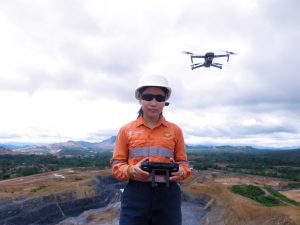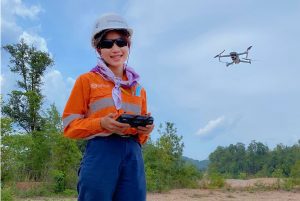Flying High: Meet LXML’s Drone Pilots
June 11, 2021
The first modern drone – unmanned aerial vehicle – was developed in 1935 to train pilots. Since then, drones have been used by various industries from the military to agriculture, entertainment, and mining.
At LXML we use drones to help us to meet mining goals and keep our employees and communities safe. Drones are excellent tools to accomplish mine planning, operational, environmental, and community management work. Drones give us an expansive aerial view of a large footprint and enable us to access remote areas.
24 LXML employees from our mining, environment, and community relations teams – three of which are female – pilot our drones for day to day work.
Drill and blasting operations routinely take place at Sepon before we can mine ore. Our pilots fly drones every day to ensure people and animals are not within the exclusive zone (500m radius) before blasting. We also use post-blasting footage to analyse and monitor safety aspects, especially when the blast is near communities.
In mining activities, drones are used to explore terrain, plan pits, capture mining progress, assess vehicle traffic, and verify operational conditions. In environment, drones help us review rehabilitation and water management activities. In our community work, drones support grievance resolution and land access work.
Let’s meet three of LXML’s female drone captains and acknowledge their skills.
Chanthavy Inthasouk, Drill and Blast Engineer, a Vientiane Capital resident
Chanthavy is the only female among five members in the Drill and Blasting Team who can operate a drone. She joined LXML in April 2020.
“I trained how to operate a drone for a week and have now been flying for a year. I find it particularly challenging flying a drone in the rainy season, flying over steep mountains, and when the signal cuts off between the drone and controller!”
Bountone Sitthideth, Grievance and Cultural Heritage Officer, a Vilabouly District resident
Bountome is the only female among four members of the Community Relations team who can operate a drone.
“I trained to operate a drone for one month and have been flying for six months. I fly drones to get a clear view of areas that may have potential impacts from our operations, such as community ponds, or rice paddies. Drone images help us to assess community grievances. I think it is very important for drone operators to focus and concentrate when flying in difficult landscapes like steep mountains.”
Bouaphanh Phienasa, Engineer – Mining Continuous Improvement, a Vientiane Capital resident
Bouaphanh is the only female among five members in the Mining Team who can operate a drone.
“I trained for two weeks and started flying in early May. I find the best time to fly a drone is after 10.00am when there is good lighting with little wind. Our department uses drones for several tasks; to review drill and blast activities, capture mining progress on different pits and plot the evolution in time of various development activities, among other things. Drones let us have great views of the operation to have better insights.”






